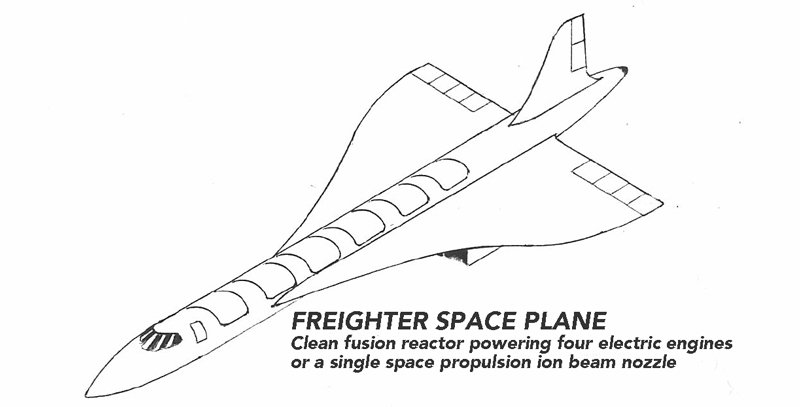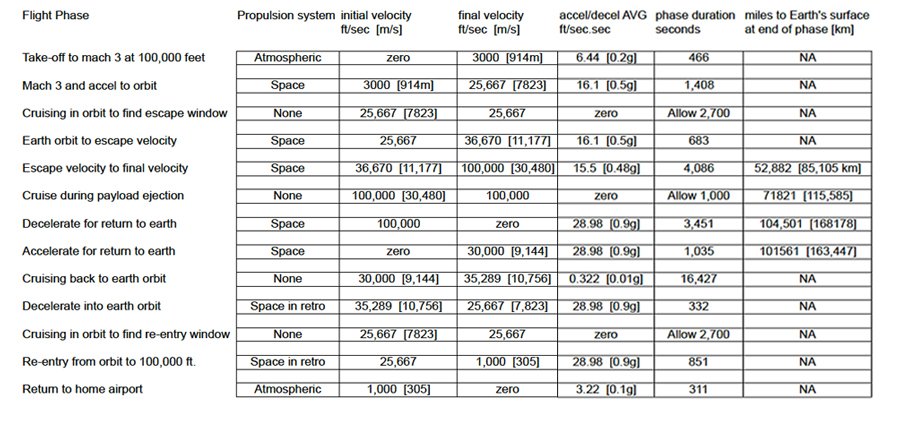My article issued November 30th. 2012, briefly describes the removal of fissile material [complete with necessary shielding] via a freighter space-plane, from this planet and deliver it to a trajectory in space that would, after release from space-plane, result in it impacting the sun.
On impacting the sun’s surface, the fissile material would be subject to intense nuclear processes that would have the overall effect on the suns surface activity, as a grain of sand has on a beach. This processing of fissile material is, I believe, a much more effective and harmless solution to disposal than the alternative contamination threat that exists [for thousands of years] to this planet and all living species, if we try to store and secure the stuff here on earth.
The following data and flight analysis provide the primary mathematics that would enable each freighter [in a fleet of 10] to complete a round trip delivery in approx. *10 hours and thus in due course of experience to make a shipment on a daily basis. After a thorough testing and proving campaign it may be possible to operate these freighters entirely by remote control [similar to the latest technology drones] thus removing the risk of pilots [through malfunction] not returning from a delivery!
The maximum velocity achieved by the space-plane, prior to propulsion ion beam shutdown and payload release, is vectored in such manner that the orbital velocity [around the Sun] has reached zero and the payload is in free-fall toward the sun’s surface.
Space-plane basic details:
Max. take-off weight including hydrogen/boron fuel for the fusion reactor and 200,000 lbs of payload = 450,000 lbs
The atmospheric propulsion system – 4 multistage electric motor driven fans [with electric heaters downstream for operation at altitudes above 30,000 ft.].
At take-off, each engine would provide a maximum thrust of 45,000 lbs [giving an acceleration down runway of 0.4 g].
For propulsion in space, a single ion beam nozzle [perhaps energy enhanced with surplus reactor power output] would provide a thrust of 225,000 lbs giving an acceleration rate of 0.5 g. * After ejection of payload and because of the reduced weight of space-plane during the homeward bound segment of the flight plan, the acceleration [deceleration] rate would increase to 0.9 g.
Small thrusters for re-orienting space-plane complete with appropriate fuel would be provided.
A cargo hold suitable for standardized containers and served with hatches and payload ejection pistons would be accommodated in a fuselage with an internal diameter of 150 inches.
The structure of the space-plane would be from composites having high strength and high temperature capabilities.
When passing through the atmosphere speeds will never exceed [especially its upper reaches during re-entry] mach 3 so that no surface insulation layers are required.
The arrangement of the space-plane [in regard to supersonic intakes and exhaust systems serving the 4 engines] will resemble the proven technology incorporated in the Concorde supersonic airliner.
Flight Plan Analysis [download .xls]
The total duration of round trip is 35,450 secs. [9.847 hours].
The total duration of fusion reactor operation is 12,623 secs. [3.506 hours].
The vectoring of the space-plane ion beam propulsion system, during the burn to achieve a velocity of 100,000 ft/sec [relative to the earth] and to achieve an orbital velocity [relative to the sun] of zero, will result in the released payload, having a velocity toward the sun [with zero orbital drift] of 20,954 ft/sec which will progressively increase with the increasing gravitational pull of the sun. The payload will impact the sun’s surface approximately 60 days after release from space-plane.
Of course all the data above is based on the successful experimentation and development of the subject prototype fusion reactors [identified in the “Varney Protocol”] and the efficient harnessing of the energy generated from this proposed process.
The future adaption of this Freighter Space-plane to a 100 or even 200 passenger transport providing flight plans that include a lunar orbit [round trip of less than 24 hours] is not, in itself, a difficult progression once the freighter project is proven and implemented.
Back to John Varney


